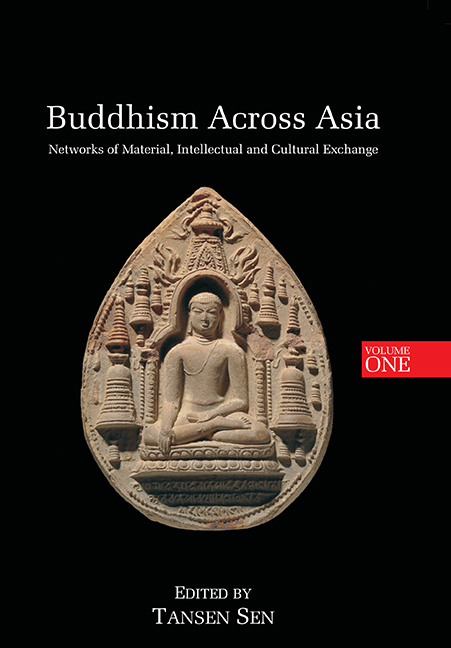Book contents
- Frontmatter
- Dedication
- Contents
- Introduction: Buddhism in Asian History
- Part I Tran smissions of Buddhism Before the Seventh Century
- 1 Networks for Long-distance Transmission of Buddhism in South Asian Transit Zones
- 2 Truth and Scripture in Early Buddhism: Categorial Reduction as Exegetical Method in Ancient Gandhāra and Beyond
- 3 Now You Hear it, Now You Don't: The Phrase “Thus Have I Heard” in Early Chinese Buddhist Translations
- 4 The First Āgama Transmission to China
- 5 What is a “Hīnayāna Zealot” Doing in Fifth-Century China?
- 6 Meditation Traditions in Fifth-Century Northern China: With a Special Note on a Forgotten “Kaśmīri” Meditation Tradition Brought to China by Buddhabhadra (359-429)
- 7 Transmission of the Dharma and Reception of the Text: Oral and Aural Features in the Fifth Chapter of the Book of Zambasta
- Part II Buddhism Across Asia between the Seventh and Fifteenth Centuries
- Part III Buddhist Connections after the Fifteenth Century
- List of Contributors
- Index
- Miscellaneous Endmatter
3 - Now You Hear it, Now You Don't: The Phrase “Thus Have I Heard” in Early Chinese Buddhist Translations
from Part I - Tran smissions of Buddhism Before the Seventh Century
Published online by Cambridge University Press: 21 October 2015
- Frontmatter
- Dedication
- Contents
- Introduction: Buddhism in Asian History
- Part I Tran smissions of Buddhism Before the Seventh Century
- 1 Networks for Long-distance Transmission of Buddhism in South Asian Transit Zones
- 2 Truth and Scripture in Early Buddhism: Categorial Reduction as Exegetical Method in Ancient Gandhāra and Beyond
- 3 Now You Hear it, Now You Don't: The Phrase “Thus Have I Heard” in Early Chinese Buddhist Translations
- 4 The First Āgama Transmission to China
- 5 What is a “Hīnayāna Zealot” Doing in Fifth-Century China?
- 6 Meditation Traditions in Fifth-Century Northern China: With a Special Note on a Forgotten “Kaśmīri” Meditation Tradition Brought to China by Buddhabhadra (359-429)
- 7 Transmission of the Dharma and Reception of the Text: Oral and Aural Features in the Fifth Chapter of the Book of Zambasta
- Part II Buddhism Across Asia between the Seventh and Fifteenth Centuries
- Part III Buddhist Connections after the Fifteenth Century
- List of Contributors
- Index
- Miscellaneous Endmatter
Summary
Much ink has been spilled in recent years on the proper interpretation of the famous opening formula beginning with “Thus have I heard . . .” (Skt. evain mayā śrutam, Pāli evain me sutain) that appears at the beginning of most Buddhist sūtras. The issue is, first of all, how to divide the components of this formula—that is, whether the subsequent phrase “at one time” (Skt. ekasmin samaye, Pāli ekain samayain) is to be construed with what precedes it, with what follows it, or with both. At least three different interpretations of this opening formula, based on three different ideas of how to punctuate it, can be found in modern scholarly studies. Giving each of these three options in English, together with the corresponding wording in Sanskrit, they are the following:
“Thus have I heard. At one time the Blessed One was staying at . . . in . . .” (evain mayā śrutam | ekasmin samaye bhagavān [+ place name] viharati Sma [+ additional location details]);
“Thus have I heard at one time. The Blessed One was staying at . . . in . . .” (evain mayā śrutam ekasmin samaye | bhagavān [+ place name] viharati Sma [+ additional location details]); and
“Thus have I heard at the one time when the Blessed One was staying at . . . in . . .” (evain mayā śrutam ekasmin samaye bhagavān [+ place name] viharati sma [+ additional location details]).
Sources of various types have been adduced to support one or other of these interpretations, including the actual punctuation found in manuscripts and printed texts of sūtras in Sanskrit, Pāli and Tibetan, the treatment of the phrase in Indian and Chinese sūtra commentaries, and the wording of the formula in Tibetan translations of Buddhist sūtras. Relatively little attention has been paid, by contrast, to the treatment of the formula in Chinese sūtra translations themselves, perhaps because it has been assumed that – since Chinese texts were not punctuated until relatively recent times – they cannot help us to determine where (if at all) the opening formula should be divided.
In fact, however, the data provided by Chinese translations is of considerable Importance.
- Type
- Chapter
- Information
- Buddhism Across AsiaNetworks of Material, Intellectual and Cultural Exchange, volume 1, pp. 39 - 64Publisher: ISEAS–Yusof Ishak InstitutePrint publication year: 2014

